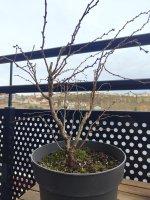Hello good people of BonsaiNut.
I want to ground layer this Prunus at the point of inverse taper. The tree was bought during a fall sale last year, and I want to repot it into better soil this spring. Would attempting a ground layer at the same time be possible? Does anyone have any tips for the best way to go about it? Do I need to purchase rooting hormone to be successful? Also, should I wait until the flowers are about to burst, or wait for leaves to come? Seems to be a little different advice and practice on this, from what I have read.
Any advise or help would be much appreciated. Also any tips for styling. I bought another Prunus as well, that I will be planting in the ground to grow, as I want a big Prunus bonsai as well in the future.
Thanks in advance

I want to ground layer this Prunus at the point of inverse taper. The tree was bought during a fall sale last year, and I want to repot it into better soil this spring. Would attempting a ground layer at the same time be possible? Does anyone have any tips for the best way to go about it? Do I need to purchase rooting hormone to be successful? Also, should I wait until the flowers are about to burst, or wait for leaves to come? Seems to be a little different advice and practice on this, from what I have read.
Any advise or help would be much appreciated. Also any tips for styling. I bought another Prunus as well, that I will be planting in the ground to grow, as I want a big Prunus bonsai as well in the future.
Thanks in advance

